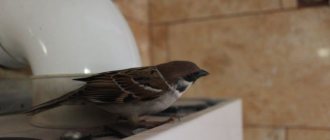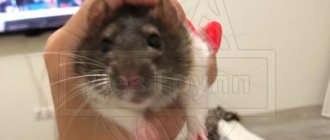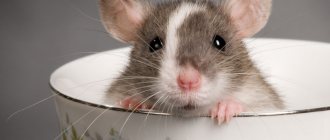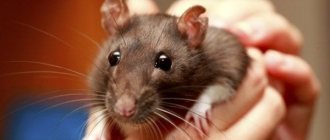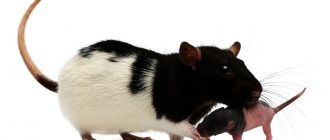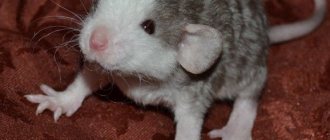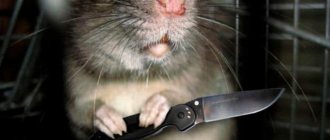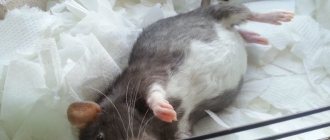You are mistaken if you think that man dominates the Earth. For a long time now, all continents, cities, villages and almost every corner of nature have been subjugated by an animal whose name is the Pasyuk rat, or simply the gray one. Most of us can't stand them. And they do the right thing, because rats eat up a huge part of the harvest, maim domestic animals and birds, and give us fatal diseases. But on the other hand, in laboratories they give their lives in thousands, helping us understand diseases, including cancer and AIDS, testing the effects of toxins and new drugs on themselves, “working” on the secrets of genetics and psychology. Do you know how the Pasyuk rat lives? How does one look for a mate? How to raise offspring? Why does it settle next to a person? We will tell you all the most interesting things about rats.
Where did they come from
12 thousand years ago, gray rats lived only in East Asia. The Ice Age left them a small space, where Eastern China is now located.
With warming, the pasyuk rat slowly occupied Altai, Primorye, Transbaikalia and southern China. But large-scale migrations occurred with the development of navigation. It was on ships that the tailed animals moved to Europe, Australia, Africa, America, populating all populated areas and suitable natural spaces. Now they are not found only in Antarctica and the Arctic. Since they arrived in new places on ships, even a certain John Berkenhout, an English naturalist, dubbed them Norwegian rats, thinking that schooners and boats came to England from there, and not knowing that at that time there were not a single rat in Norway. Despite the error, the species name Rattus norvegicus still exists today.
Ways to control rodents
Let's look at the most effective ways to protect your home and property.
Toxic substances
There are many types of poisons in specialized stores.
All poisons can be divided into strong and weak effects.
- The first category includes zinc phosphide. The poison acts quickly . Once in the stomach, it begins to react with hydrochloric acid and forms hydrogen phosphide, which stops breathing. A 3% concentration of poison is suitable for the death of an animal. It is good because it will not cause poisoning in other animals if they eat a poisoned rat.
- Long-acting substances are more suitable for controlling small rodents. It may take quite some time until the poison accumulates in the body and destroys the animal. In addition, the gray rat’s body is more resistant to poison and can get used to it, so from time to time the type of substance will have to be changed.
What types of poison can be used?
- Treats soaked in poison (grain, cheese, bread, pieces of meat). The method is effective and most common.
- Liquid baits are chemicals dissolved in water and milk.
- Powdered chemicals - for pollinating burrow exits and other places where barn rats might be seen.
- Gaseous chemicals - used, for example, to irrigate burrows. This method should be used with caution, especially in residential areas.
Mechanical traps
Advice! Do not fully charge the mousetrap at first. Let the rodents eat the left baits several times. Rats will get used to taking the left treat and will not suspect that a click will soon occur and the trap will work.
Placing a mousetrap is the easiest way, but not reliable. The barn rat is larger than the vole, so a standard simple mousetrap will not work for it.
In addition, after catching 1-2 rodents, they do not want to go into the mousetrap even with the most exquisite bait.
Ultrasonic repellers
Quite an effective way . Modern devices are effective. Ultrasonic waves negatively affect the psyche of rodents and force them to leave populated areas.
Attention! For good results, the device must work constantly. In addition, when purchasing, it is important to compare the size of the area where the device will be used and the duration of the emitted wave. A universal, standard repeller is suitable for a barn, barn, or home. If you are going to install it on a large area, take care of purchasing several devices.
Path closure
Another not bad way to fight. You can get rid of gray rats in your house or barn by blocking the paths.
Try to figure out the passages, loopholes, paths along which the pasyuk makes its way into the house, and sprinkle calcium chloride . Rodents cannot tolerate this powder.
Rat holes and passages can be covered with cement and crushed glass . It will be extremely difficult for them to gnaw through such a wall.
All methods are good in the fight against the hated gray rodents.
In order for the work to be done effectively, it is better not to settle on any particular method, but try to change them or use them in combination.
Then your home and area will not be afraid of even such unpleasant pests as gray rats.
Rat Pasyuk: description
Among their relatives, these rodents are considered large. Males grow up to 25 cm in length, plus a 19 cm hairless tail. In this case, the weight of an adult individual can be up to 400 grams. The sizes of females are slightly more modest. There are no other external differences. The pasyuk's muzzle is often not very elongated, and the ears are small. The fur of rats is conventionally gray, but there may also be red, dark, brownish shades, similar to those of agouti, which is why they are called brown abroad. Rarely, there are pure black and pure white Pasyuki. The abdomen of all is also white, and throughout the body there are long guard hairs, often dark at the base. There are two subspecies of pasyuks - Indian and East Asian. Rats have a chromosome set of 42 units, and they have 25,000 genes, so all sorts of combinations are possible.
Why do animals need a tail?
Often, young children, just beginning to explore the world around them, ask their parents the same question: “Why do animals grow tails?” It should be noted that not every parent is able to give a clear and truthful answer to this simple question.
Usually the answer is banal phrases about how this is how it works. But inquisitive little minds are rarely satisfied with such a general answer and continue to look for more specific reasons.
Especially for these inquisitive kids, as well as for the peace of mind of their parents, we inform you: there really are such reasons.
Tails grow because without them, many animals would feel “as if they had no arms.” With the help of the tail, animals can communicate and express their emotions, find new friends and scare away opponents, defend and attack, keep warm, give danger signals, climb trees, steer their own body when running, jumping, flying or swimming, maintain balance or just have fun. Tails play a very important role in the lives of most animals.
Sources
- https://homkin.ru/krysy/osobennosti-krys/hvost-krysy.html
- https://moy-homyachok.ru/domashniaya-krisa/xvost-krysy.html
- https://rat911.ru/krysy/dlya-chego-krysam-dlinnyj-xvost/index.html
- https://likehamster.ru/domashnie-krysy/povadki-krys/krysinyj-hvost/
- https://www.vseznaika.org/biology/zachem-zhivotnym-nuzhen-xvost/
Behavior
The gray pasyuk rat is a social animal; in nature it lives in groups; it rarely tolerates loneliness. One family can occupy a territory of up to 2 square km, which is carefully marked and guarded. But if necessary, called “food production,” the boundaries of the territory are easily expanded. A family can have from 100 to 2000 members. Among male rats, like other mammals, there is a strict hierarchy consisting in the selection of females for prolongation of the family. But there is no help and protection for each other here. Rats are always for themselves. They are very smart, have a good memory, if everything suits them, they are not aggressive, but they know how to stand up for themselves. Rats fight excellently, not only with their relatives, but also with large animals. Previously, English sirs even staged spectacular rat-dog fights, which, fortunately, have already been banned.
Danger to people
Rats bites and scratches can cause illness and fever in humans. Rat urine is responsible for the spread of leptospirosis, which can cause liver and kidney damage. Complications include kidney and liver failure, as well as cardiovascular problems.
Lymphocytic choriomeningitis (LCMV), a viral infectious disease, is transmitted through the saliva and urine of rats. Some people experience long-term effects of lymphocytic choriomeningitis, while others experience only temporary discomfort.
One of the deadliest rat-borne diseases in history is the bubonic plague, also called the “black plague.” Transfer occurs when a person is bitten by fleas from rats. Fleas carried by rats are believed to be responsible for this plague in the Middle Ages, which killed millions of people. From bubonic plague to typhus and hantavirus, rat infestation can be hazardous to human health.
Rats are also a potential source of allergens. Their feces, dandruff and lost hair can cause sneezing and other allergic reactions.
Diseases transmitted by rats can be divided into two categories: diseases transmitted directly through contact with infected rat feces, urine, or bites, and diseases transmitted indirectly to humans through intermediate arthropod vectors such as fleas, ticks, or mites. Although all of the diseases or medical conditions listed below are associated with rats, most of them are not commonly encountered today.
Diseases directly transmitted by rats
- Hantavirus pulmonary syndrome: This is a viral disease transmitted by some rats. This disease is spread in one of three ways: by inhaling dust contaminated with rat urine or droppings, by direct contact with rat feces or urine, and, infrequently, by rat bites.
- Leptospirosis: This is a bacterial disease that can be spread through contact with contaminated water through swimming or through contaminated drinking water. People may be at increased risk of contracting leptospirosis if they work outdoors or with animals.
- Rat bite fever: This disease can be transmitted through a bite, scratch, or contact with a dead rat.
- Salmonellosis: Consuming food or water contaminated with bacteria from rat feces can cause this disease.
Diseases transmitted indirectly from rats
- Plague: This disease is carried by rats and transmitted by fleas through blood ingestion. Domestic rats are the most common reservoir of plague.
- Colorado tick fever: This is a viral disease transmitted by the bite of a tick that has ingested the blood of a brushwood tick.
- Cutaneous leishmaniasis: This disease is a parasite that is transmitted to humans by the bite of an infected sand fly that has eaten a wild tree rat.
Hantavirus
Some species of rats, such as cotton rats, are known carriers of hantavirus. Norwegians are not able to transmit this disease. Victims may be weakened and have difficulty breathing. Hantavirus is transmitted to people when they inhale airborne particles from the droppings, urine or carcasses of rodents that have been killed.
The first symptoms of the virus can be mistaken for the flu. Patients then suffer from difficulty breathing, which can prove fatal if not treated immediately and effectively.
To avoid hantavirus, you must remove all mouse droppings, nesting materials, and dead rodents from your home. Before cleaning, thoroughly spray suspicious areas with disinfectant to ensure nothing gets into the air. Wear gloves when handling rodent carcasses or droppings, and use a respirator with proper cartridges. After cleaning, the building should be ventilated. Not all rodents carry hantavirus. Cotton rat mice are the most common vectors. However, everyone should exercise caution when dealing with rodents or rodent infestations and contact a pest control professional.
Nutrition
The pasyuk rat is an omnivorous animal. In nature, her menu includes grains, vegetables, fruits and, of course, proteins: eggs, chicks, fish, seafood (stolen or thrown onto the ground), insects, small rodents, sometimes even feces. Having settled near humans, the rats somewhat changed their gourmet tastes. Now their menu includes any leftover food, unattended food (especially grain in granaries), as well as electrical wiring, books, and other things people need. An interesting fact: in order to get a tasty morsel, a rat is able to squeeze into a hole where its relatively small head could fit. Pasyuki have chosen warehouses, basements, subways for themselves, and in their homes they freely travel through the sewer network and garbage chutes.
Prevention measures
To ensure that rats are as little interested in your home as possible, you need to monitor its condition and follow the following recommendations:
- do not leave trash and keep order in the area around the house;
- eliminate the presence of even the smallest through holes in the walls or roof;
- get rid of sources of standing water on the site;
- do not leave leftover food outside at night;
- get a cat or dog of a breed that is excellent at hunting rodents.
Reproduction
The pasyuk rat is simply fantastically prolific! The photo above shows a 3-day-old brood. These tailed animals become sexually mature at 3 months of age! Females can have up to 20 cubs in a litter. Often 3-4 mothers create a common nest to take care of the babies. Scientists have noticed that in such cubes the bodies of newborns are sometimes intertwined, and it seems that the grown-up rat pups have two or three heads. Perhaps this became the prototype of the rat king from The Nutcracker.
In nature, animals build nests in hollows or dig shallow holes. In cities they are located in any suitable place. A female who has delivered her pregnancy can conceive again within 18 hours, and her pregnancy lasts only 24 days. Can you imagine how rapidly the rat population is increasing!
Newborn baby rats are real crumbs weighing up to 5 grams. A hungry father can feast on them, and sometimes even a mother, if she thinks the children are too weak. But generally, the females are quite caring, licking their tailed children, feeding them very nutritious milk, and putting things in order in the nest.
Children remain blind for up to 17 days, but already at the age of 1 month, and sometimes at just 21 days of age, they begin to live independently. Now there are about 15-18 billion rats on Earth, almost twice as many as us humans. And this despite the fact that the growth of their population is restrained by diseases, predators, people and a too short life span, not exceeding three years even in the most ideal conditions.
Records
The Pasyuk rat can surprise you with its abilities. In case of danger, it jumps up to 80 cm in height, up to 1 meter in length, accelerates up to 10 km/hour, can swim in water for 3 days, and covers up to 17 km on land in a day. These animals are, one might say, extreme sportsmen. They can live and even reproduce at -18°C. Thus, in one of the meat freezers, rat nests with babies in frozen carcasses were discovered. They calmly tolerate heat up to +45°C, and even radiation up to 300 roentgens per hour. Where atomic explosions were carried out and all living creatures were destroyed, only the pasyuk rat remained unharmed. Their small ears are able to detect the smallest noise in the 40 kHz range. We only pick up up to 20 kHz, which is great for ultrasonic repellers.
But the eyesight of rats is rather weak. Their viewing angle is only 16°, so they have to turn their heads often. Of the colors they distinguish only bluish-green, but basically they see everything in gray colors.
Each individual needs only 20 grams of food per day, but in a year this amounts to 10 kg. Without food, rats can survive only 4 days. It was the search for food that became the reason for their resettlement to new territories. Pasyuki need water no less. If their menu consists only of dry food, they can live for only 5 days without drinking. If the feed contains at least 50% moisture, it lasts for almost a month without water.
Lifestyle Features
Pasyuki are fans of shadow hunting. Their activity occurs in the evening and night hours (19.00-8.00), but the peak is 20.00-22.00. True, if the need arises, they can be active during the daytime.
They live in families (colonies) and are very aggressive when strangers appear on their territory. Members of their herd are recognized by smell. The natural homes of rats are holes, other people's nests, previously destroyed, hollows, stumps, and snags. “City” residents - pasyuki live in basements, garages, garbage heaps, sewer mines, etc.
The diet consists of food waste from garbage dumps, fish, meat, agricultural crops, etc. Rats have exceptional survival, adaptive qualities, a sharp mind, caution and resourcefulness. In addition, the gray scammer swims well, dives, jumps almost a meter in height and is capable of reaching speeds of up to 12 km/h.
Harm and benefit
Rodents that live only in nature rarely bother people. All they can do is gnaw vegetables in the garden or grain in the fields. The Pasyuk house rat is much more unpleasant. There are two varieties here - those who live with people constantly, and those who move to people only in cold weather. Both are capable of completely destroying food supplies, cutting off power to homes and entire areas by gnawing through wiring, eating the paws of poultry and rabbits, killing rabbits, chickens and other chicks. But the worst thing is that rats carry plague, typhus, Q fever, salmonellosis, helminths and other infections. For all these reasons, people are constantly fighting with pasyuks, poisoning them, setting traps.
But on the other hand, it is rats, thanks to their fantastic fertility, that are the main experimental animals on which they test medications, conduct a bunch of experiments, infecting them with all sorts of diseases, in order to later find a cure for them. Therefore, despite the damage caused by pasyuks, you need to have some respect for them.
Appearance
Outwardly, all rats are similar. However, the black rat differs from the more familiar Pasyuk in several ways:
- Size . Black rats are slightly smaller than their gray relatives. Their body length, depending on gender and age, ranges from 16-22 cm. And their weight ranges from 150 to 300 g.
- Head . The face of black rats is more pointed and extended forward. The ears, on the contrary, are larger and have a rounded shape. The parietal ridges are curved in the shape of an arc.
- The tail is 30-35% longer than the body. On average it reaches a length of 29 cm. Completely covered with hairs.
- Wool . Black rats have soft, shiny fur. Even in older individuals, the fur coat looks quite decent.
It is worth noting that, contrary to their name, representatives of this species are not only black in color. Sometimes there are individuals with white or gray-yellow coats.
Pets
It turns out that there are people who take great pleasure in dealing with rats and even saving them from harm. One such rat-loving community is called Felis Lynx (rats). “What happened to Pasyuk?” - This is one of the topics on their forums on the Internet. A community has been created to help everyone who wants to have a little rat at home with advice, because raising a little rat is not so easy. There are people in the community who raise exclusively domesticated animals, which are more sociable, not at all aggressive, like little living lumps that require love and care. But there are people who undertake to release wild rat pups. Pasyuki also get used to captivity, with difficulty, but they are tamed, respond to the name, and can even allow themselves to be played with. But for example, males have a harder time tolerating the appearance of a stranger in their cage, they can even bite it to death, and at first they have difficulty with cleaning the cage or food bowl.
Interesting Facts
- Rats are very clean animals, grooming themselves several times a day. In fact, they are less susceptible to contracting and transmitting parasites and viruses than dogs or cats.
- Rats are social creatures. They communicate with each other using high-frequency sounds that we cannot hear without special instruments. Cases have been recorded of mice “singing” like birds, but at ultrasonic frequencies. They play together, wrestle and love to sleep curled up in a ball. Like us, if they don't have company, they can become lonely, anxious, depressed and stressed.
- Rats have complex communication systems. They can communicate through touch, smell and sound at frequencies we cannot hear.
- Wild rats can be sympathetic. In one ethically questionable study, the vast majority of rats tested chose to help another rat that was being forced to tread water, even when offered a chocolate treat instead.
- Rats can recognize and respond to pain expressions on the faces of other rats.
- These animals are so smart that they can recognize their names and respond when called.
Selection
The greater fertility of rats helps to breed numerous breeds of them. They differ mainly in the color of their eyes and fur. There are even sphinx rats (hairless), downy rats (with delicate fluff instead of fur) and double rex rats (these areas on the body that are covered with fur change throughout their lives). A hybrid of a pasyuk and a decorative rat, which has lost some of its former talents, can also be obtained. This is what they do in the “Home Pasyuk” project. Children from such a union are born not only of a wide variety of colors, but also stronger and more intelligent. True, sometimes these offspring turn out to be somewhat aggressive. In general, messing with rats is very interesting. They are affectionate, clean animals, eat little, are trained and take up very little space in the apartment.
Morphology
Body length up to 275 mm, tail length up to 195 mm. The tail is shorter than the body, which is especially typical for forms living in the wild. On average, the tail makes up about 80% of the body length.
The muzzle is wide and blunt. The auricle will not reach the eye if it is bent in its direction. Tail with sparse hair. The foot is long (up to 45 mm).
The color varies from light, reddish-brown to dark, dirty-ochre-brown. In the bulk of the hair, longer and stiffer guard hairs with a metallic sheen stand out. On the ventral side the hair has a dark base.
The skull is angular in shape, the ridges are well developed. The masseter plate of the maxillary bone is large, with a strongly projecting upper angle and an anterior edge inclined anteriorly. The maximum width of the skull in the zygomatic arches occurs in their middle or posterior third. The narrowest part of the brain capsule is in the middle of the frontal bones. Skull length 39.0 – 45.2 mm.
